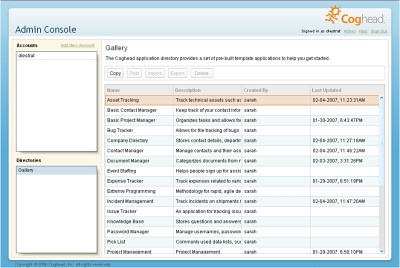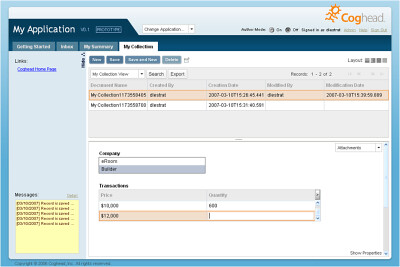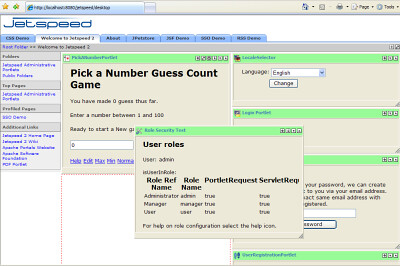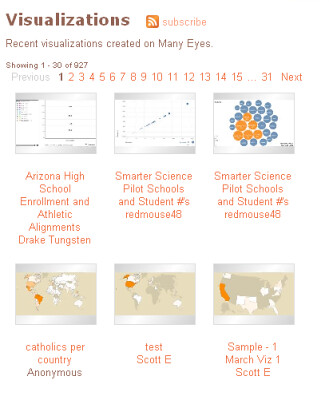I have been a long time My Yahoo! user and over time have accumulated quite a collection of personalized content. But lately, with new and innovative services like Netvibes and PageFlakes, I had grown overly frustrated with the lack of investment in My Yahoo! and had been considering migrating away from using it. Finally, it looks like Yahoo! has decided to change course and some exciting new features are coming our way. The new My Yahoo! is currently offered in Beta to a limited number of users. For a preview of what's coming, check out this screencast. Also, Yahoo! is starting a new My Yahoo! blog that will hopefully give users a good sense of where things are going.
So, I guess I will wait a little longer and see if the new My Yahoo! finally gets to par with its competition.
Sunday, March 18, 2007
Saturday, March 10, 2007
Build Your Own Application With Coghead
I have been invited to participate in Coghead beta program. Coghead's catch line is a:
Their application is built using OpenLaszlo and provides a very responsive user experience. I have been evaluating their application and they definitely get the idea right. End users have a multitude of needs for business application. We could refer to this as the long tail of business applications. And IT cannot respond to everyone of those needs in a scalable manner. Therefore it makes sense to create an application that empowers business users to quickly create applications as their needs occur. Coghead Gallery provides a number of application templates to quickly get started.

Where I personally find that Coghead falls short is with its concept of collection Coghead allows users to build applications made collections, forms, views, and actions. Collections are objects used by the application. They contain records. A collection describes a data structure, and provides tools for viewing and modifying data of that type. Records are the actual data that is stored; each record is an instance of the data defined by the Collection. For example, if you have a collection “Purchase Orders” then a record would be the data that makes up one purchase order.
Though a powerful concept, it does not go far enough in my opinion. Business application needs go beyond the need to assemble collections. Nevertheless, this is a good start and a nice application.

Simple, powerful new way to create web-based business applications that can be used by anyone, anytime, anywhere!
Their application is built using OpenLaszlo and provides a very responsive user experience. I have been evaluating their application and they definitely get the idea right. End users have a multitude of needs for business application. We could refer to this as the long tail of business applications. And IT cannot respond to everyone of those needs in a scalable manner. Therefore it makes sense to create an application that empowers business users to quickly create applications as their needs occur. Coghead Gallery provides a number of application templates to quickly get started.

Where I personally find that Coghead falls short is with its concept of collection Coghead allows users to build applications made collections, forms, views, and actions. Collections are objects used by the application. They contain records. A collection describes a data structure, and provides tools for viewing and modifying data of that type. Records are the actual data that is stored; each record is an instance of the data defined by the Collection. For example, if you have a collection “Purchase Orders” then a record would be the data that makes up one purchase order.
Though a powerful concept, it does not go far enough in my opinion. Business application needs go beyond the need to assemble collections. Nevertheless, this is a good start and a nice application.

Saturday, March 03, 2007
Jetspeed 2.1 Released!
Congratulations to the Jetspeed team who released Jetspeed 2.1 this week-end. Included in this release are a large number of bug fixes and some significant new features including:
All great features that will go a long way to make Jetspeed 2.1 an option for enterprise portal deployments.
The Jetspeed 2.1 release comes with a nice installer and you can try it for yourself in about 5-10 minutes.

The detailed releases notes are available on Jetspeed-2 web site.
Below is a screenshot of the new Jetspeed-2 desktop client side aggregation.

- Jetspeed Desktop: a web 2.0 client-side JSR-168 portlet aggregation
- Parallel Rendering: multithreaded portlet aggregator with portlet timeout tracking and removal of slow rendering portlets
- Jetspeed Distributed Cluster: support for distributed deployments of the portal on multiple application server platforms
- JSR 168 Caching: full caching support of the JSR-168 portlet specification and distributed cache invalidation
- Improved LDAP support: full security maintenance using LDAP is now supported for many LDAP providers
- Full fledge AJAX API
All great features that will go a long way to make Jetspeed 2.1 an option for enterprise portal deployments.
The Jetspeed 2.1 release comes with a nice installer and you can try it for yourself in about 5-10 minutes.

The detailed releases notes are available on Jetspeed-2 web site.
Below is a screenshot of the new Jetspeed-2 desktop client side aggregation.

Thursday, March 01, 2007
Data Sharing and Vizualization: Next Generation
The International Weekly Journal of Science has published an interesting article illustrating how social software us creating a new paradigm for sharing data. Proof in point is IBM's new Many Eyes service launched on January 23rd. The site provides an infrastructure for uploading data sets and creating visualization for the data through various visualization types available.
 By making the data publicly available and providing an infrastructure to analyze it, it empowers individuals and creates a very powerful model for developing collective intelligence quickly. Fernanda Viégas of IBM's Visual Communication Lab in Cambridge, Massachusetts points out that governments, international agencies and research organizations generate huge silos of publicly available data on almost every aspect of society, but the public has never been able to explore, share and discuss these data sets easily. That is interesting, but more interestingly, I could see huge applications of this type of technology to the enterprise with potential dynamic enterprise datasets. In the enterprise context, this type of application of social software could drastically impact organizations' ability to be more data driven and to leverage data to collaborate on business decisions.
By making the data publicly available and providing an infrastructure to analyze it, it empowers individuals and creates a very powerful model for developing collective intelligence quickly. Fernanda Viégas of IBM's Visual Communication Lab in Cambridge, Massachusetts points out that governments, international agencies and research organizations generate huge silos of publicly available data on almost every aspect of society, but the public has never been able to explore, share and discuss these data sets easily. That is interesting, but more interestingly, I could see huge applications of this type of technology to the enterprise with potential dynamic enterprise datasets. In the enterprise context, this type of application of social software could drastically impact organizations' ability to be more data driven and to leverage data to collaborate on business decisions.
Below, some more screenshots from Many Eyes.
Posted visualizations:

Posted comments:

Posted data sets:

 By making the data publicly available and providing an infrastructure to analyze it, it empowers individuals and creates a very powerful model for developing collective intelligence quickly. Fernanda Viégas of IBM's Visual Communication Lab in Cambridge, Massachusetts points out that governments, international agencies and research organizations generate huge silos of publicly available data on almost every aspect of society, but the public has never been able to explore, share and discuss these data sets easily. That is interesting, but more interestingly, I could see huge applications of this type of technology to the enterprise with potential dynamic enterprise datasets. In the enterprise context, this type of application of social software could drastically impact organizations' ability to be more data driven and to leverage data to collaborate on business decisions.
By making the data publicly available and providing an infrastructure to analyze it, it empowers individuals and creates a very powerful model for developing collective intelligence quickly. Fernanda Viégas of IBM's Visual Communication Lab in Cambridge, Massachusetts points out that governments, international agencies and research organizations generate huge silos of publicly available data on almost every aspect of society, but the public has never been able to explore, share and discuss these data sets easily. That is interesting, but more interestingly, I could see huge applications of this type of technology to the enterprise with potential dynamic enterprise datasets. In the enterprise context, this type of application of social software could drastically impact organizations' ability to be more data driven and to leverage data to collaborate on business decisions.Below, some more screenshots from Many Eyes.
Posted visualizations:

Posted comments:

Posted data sets:

Subscribe to:
Posts (Atom)